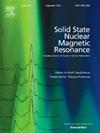使用可调电磁铁的塞曼摄动NQR光谱的实际方面
IF 2.4
3区 化学
Q4 CHEMISTRY, PHYSICAL
引用次数: 0
摘要
四极摄动固体核磁共振波谱是研究四极核的一种行之有效的方法。该方法依赖于拉莫尔频率与四极频率的高比率,因此受限于适用于核磁共振的可用磁场强度(约为101 t),核四极共振(NQR)为研究强四极同位素提供了一种方法,但在测量高频跃迁、测量四极耦合常数CQ和不对称参数η、精度很高。我们在这里描述了使用可调节电磁铁的泽曼摄动NQR光谱的现代实现的技术和实践方面,克服了上述挑战。该方法将四极摄动固体核磁共振方法颠倒过来,使四极相互作用占主导地位,塞曼相互作用为摄动。在10−2 t量级的外加磁场下,记录了固体溴和碘苯粉末的79Br和127I泽曼摄动NQR光谱,讨论了各种实验考虑因素,包括最佳磁场,线圈角度的优化,频率步进,使用泽曼四极哈密顿量的精确对角化模拟光谱,以及如何确保得到的四极参数的高精度。例如,在室温下,在不到1小时的时间内测得对称-三碘三氟苯的CQ(127)值为2077.25±1.49 MHz (η = 0.114±0.008)。该方法有望在一系列材料中研究强四极性同位素,并在许多感兴趣的情况下消除对超高磁场的需要。本文章由计算机程序翻译,如有差异,请以英文原文为准。

Practical aspects of Zeeman-perturbed NQR spectroscopy using an adjustable electromagnet
Quadrupolar-perturbed solid-state NMR spectroscopy is a highly useful and well-established method for studying quadrupolar nuclei. This method relies on a high ratio of the Larmor frequency to the quadrupolar frequency and is limited, therefore, by the available magnetic field strengths suitable for NMR, which are on the order of 101 T. Nuclear quadrupole resonance (NQR) provides an approach to studying strongly quadrupolar isotopes, but there are technical challenges associated with measuring high-frequency transitions, and with measuring both the quadrupolar coupling constant, CQ, and asymmetry parameter, η, with good precision. We describe here the technical and practical aspects of a modern implementation of Zeeman-perturbed NQR spectroscopy using an adjustable electromagnet, which overcomes the aforementioned challenges. This approach flips the quadrupolar-perturbed solid-state NMR method upside down, so that the quadrupolar interaction is dominant and the Zeeman interaction is the perturbation. 79Br and 127I Zeeman-perturbed NQR spectra are recorded for some solid bromo- and iodobenzene powders using applied magnetic fields on the order of 10−2 T. Various experimental considerations are discussed, including the optimal magnetic field to be used, the optimization of the coil angle, frequency stepping, the simulation of spectra using an exact diagonalization of the Zeeman-quadrupolar Hamiltonian, and how to ensure high precision in the resulting quadrupolar parameters. As an example, a CQ(127) value of 2077.25 ± 1.49 MHz (with η = 0.114 ± 0.008) is measured for sym-triiodotrifluorobenzene in less than an hour at room temperature. The approach holds promise for studying strongly quadrupolar isotopes in a range of materials and obviates the need for ultrahigh magnetic fields in many situations of interest.
求助全文
通过发布文献求助,成功后即可免费获取论文全文。
去求助
来源期刊
CiteScore
5.30
自引率
9.40%
发文量
42
审稿时长
72 days
期刊介绍:
The journal Solid State Nuclear Magnetic Resonance publishes original manuscripts of high scientific quality dealing with all experimental and theoretical aspects of solid state NMR. This includes advances in instrumentation, development of new experimental techniques and methodology, new theoretical insights, new data processing and simulation methods, and original applications of established or novel methods to scientific problems.

 求助内容:
求助内容: 应助结果提醒方式:
应助结果提醒方式:


